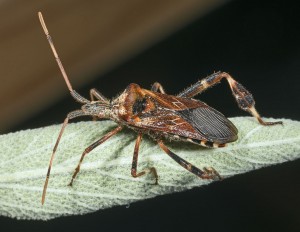“Zed, We have a Bug”
The regional Gangs and Bugs Unit of Cornell’s Horticulture Task Force has reported that roving gangs of bugs are more active than normal this fall. While these various insects are purported to be harmless, they do engage in loitering, and a few of them may actually enter homes as the weather cools, so it is unclear whether they can be entirely trusted. The authorities suggest local residents keep an eye out for any gang activity, and be ready to take appropriate action if needed.

A member of the Boxelder Bunch, wearing his distinctive gang colors. Photo: Brucy Marlin, Creative Commons, some rights reserved
One of the most notorious of these groups is the Boxelder Bunch, which has seen a dramatic increase in membership recently. According to biologists, the population spike is due to the hot, dry summer, but there may be some kind of social media-based recruitment going on. Boxelder bugs look like beetles, but are in fact hemipteras, plant-sucking insects related to leafhoppers. This deception may or may not reflect their moral character.
Their bright gang colors make them easy to identify. Before they are fully grown, these native insects sport bright red “coats,” but the adults, which are about a half-inch long, have black cross-hatch marks over a red background. They can be found hanging around in large numbers, possibly to intimidate us, on tree trunks, and on west or south-facing walls of homes and other buildings.
As their name suggests, boxelder bugs feed on boxelder (Acer negundo) trees, and other species of maples as well, siphoning sap from leaves and twigs when they think no one is looking. If you find any indoors, keep in mind that they do not breed inside homes, or seek food there, and they do not damage structures. They also don’t bite or carry disease, but they sneak in without knocking, and as a rule will refuse to pay rent for their accommodations. Also their bright colors clash with most home-decor schemes. For such reasons, you may want to vacuum them up (spraying indoors is not advised).
You can hose them off exterior walls, or treat the surface with a repellant insecticide labeled for such use. Always follow the label, and keep children and pets away from treated areas for at least a week.

A member of Western Conifer Seed Bug Amalgamation, suspicious newcomers from the west of the Rockies. Photo: Didier Descouens, Creative Commons, some rights reserved
A smaller organization is the Western Conifer Seed Bug Amalgamation, a stealthy group that keeps a lower profile. Similar to boxelder bugs, they cause no harm to people or buildings, but are not to be trusted either. First of all, why are they in our neighborhood in the first place? Native to regions west of the Rockies, they have infiltrated the rest of the country over the past two decades, feeding on sap of all species of pines.
Western conifer seed bugs dress in drab colors like brown and gray, likely in order to steal their way inside undetected. Running about three-quarters of an inch to one inch, they are larger than boxelder bugs. Another identifying feature is that their hind legs are broad in one dimension but flattened in another; such insects are sometimes called “leaf-footed bugs.”
These bugs move slowly, with a sort of deliberate, bowlegged gait like a gunslinger in an old Western. If that isn’t suspicious, I don’t know what is. As a final example of their possible malicious nature, western conifer seed bugs give off a foul odor when roughly handled or killed. Usher them outdoors or get out the Hoover; your call.

The one mild-mannered Lady Beetle Band has been overrun by aggressive Asian relations. spacebirdy, Creative Commons, some rights reserved
An organized gang since the early 1990s, the Lady Beetle Band is one of the better-known syndicates; their gang colors are instantly recognizable. Before they formed a cartel, lady beetles were more solitary, and harmless. Children considered them cute, and gardeners loved them because they ate harmful pests.
Biologists will tell you that a new, more aggressive strain of Asian multicolored lady beetle was introduced to the U.S. around 1993. However, it is also possible that these insects simply lost their moral compass through dissolute living and indiscriminate mating.
Unlike boxelder bugs, which are mere posers, lady beetles are in fact beetles. They appear in huge numbers in the fall, looking for a sheltered, rent-free spot to overwinter. Like the characters listed above, they do not breed indoors or harm structures. Despite their status as a beneficial garden insect, they have some real criminal tendencies. Theft of foodstuffs is a common offense, as they will seek sugary foods to nibble on. They also can bite, and they release a noxious odor when disturbed. When crushed, they let out all their stink, and leave a stain on fabric and wood as well.
The lady beetle gang can be managed the same way as boxelder bugs. Since they may be found in the home in larger numbers, you can take the end of an old nylon stocking and push the closed end inside the vacuum wand. Tape the open end of the nylon to the outside of the wand, and you have a mini-vacuum bag you can easily empty out.
Don’t overlook the value of caulking around windows, vents and doors, and replacing worn door sweeps and gaskets. You’ll have fewer bugs and will be be warmer, too.
For more information, or to report suspicious bugs, please call your local Cornell Cooperative Extension office.
Paul Hetzler is a horticulture and natural resources educator with Cornell Cooperative Extension of St. Lawrence County.
Tags: invasive species, nature, pests







